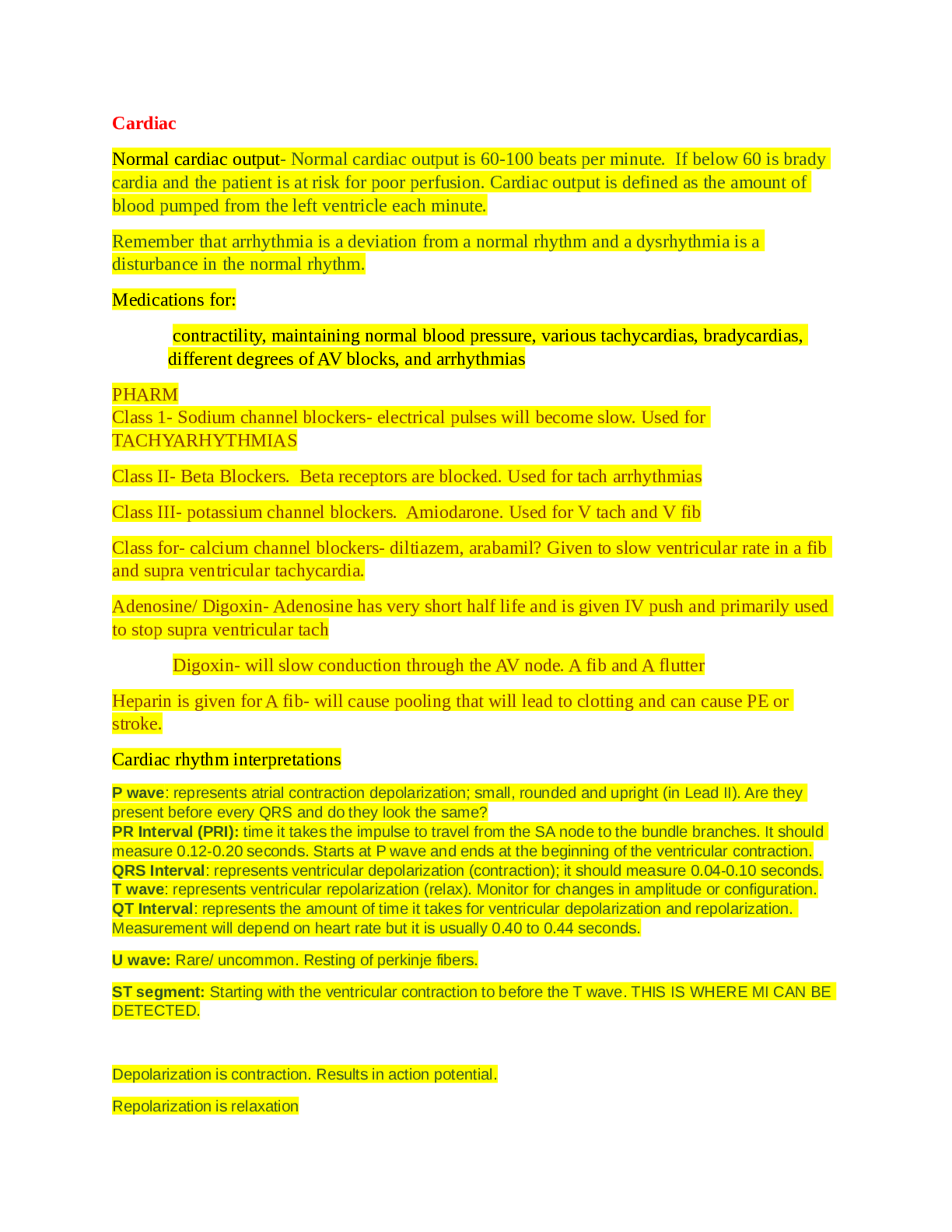*NURSING > EXAM REVIEW > Neurobiologic theories & psychopharmacology Nursing PSYCH 101 Psych UNIT 2 exam (All)
Neurobiologic theories & psychopharmacology Nursing PSYCH 101 Psych UNIT 2 exam
Document Content and Description Below
Chapter 2: Neurobiologic theories & psychopharmacology [8] Central Nervous System Consists of: – Brain o Cerebrum o Cerebellum: Receives & integrates info. From all body areas to coordinate mo... vement & posture o Brain stem: Pons, Medulla oblongata, Locus ceruleus, Cranial nerve nuclei 3-12 o Limbic system: Above the brain stem & includes: Thalamus, hypothalamus, amygdala – Spinal cord12 – Nerves that control voluntary acts Cerebrum • Divided into 2 hemispheres with 4 lobes each: – Frontal lobe (thought, body movement, memories, emotions, moral behavior) – Parietal lobe (taste, touch, spatial orientation) – Temporal lobe (smell, hearing, memory, emotional expression) – Occipital lobe (language, visual interpretation)Neurotransmitter Drugs Dopamine (control of complex movements, motivation, cognition, regulation of emotional responses) *when you mess w/dopamine, you get very significant S/E [some permanent] Norepinephrine (attention, learning, memory, sleep, wakefulness, mood regulation) Epinephrine (flight-or-fight response) Serotonin (food intake, sleep, wakefulness, temperature regulation, pain control, sexual behaviors, regulation of emotions) Old generation of these meds treated + side effects of schizophrenia, but these patients couldn’t go back and be a regular person in society again. [old generation meds caused DECREASE dopamine in brain… caused Parkinson’s side effects] Histamine (alertness, control of gastric secretions, cardiac stimulation, peripheral allergic responses) Acetylcholine (sleep and wakefulness cycle, signals muscles to become alert) Glutamate (an excitatory amino acid) GABA (modulates other neurotransmitters) *ppl w/ anxiety have GABA Brain imaging techniques • Computed tomography (CT) • Magnetic resonance imaging (MRI) • Positron emission tomography (PET) • Single photon emission computed tomography (SPECT) We cannot yet diagnose mental illness with these techniques aloneCauses of mental illness • Genetics and heredity: play a role but alone do not account for development of mental illness • Psycho-immunology: a compromised immune system could contribute, especially in at-risk populations • Infections, particularly viruses, may play a role Psychopharmacology • Psychopharmacology and medication management are important in the treatment of many mental illnesses o Approved uses o Off-label uses; anticonvulsant meds used for bipolar disorder o Black box warnings; BAD S/E like may cause suicide [really gets your attention] Principles of Psychopharmacology Principles that guide the use of medications include: Effect on target symptom Adequate dosage for sufficient time Lowest dose needed for maintenance [when meds like halodol are given as PRN (small dosages) they’re given as sedatives] Lower doses for the elderly [everything slows down (metabolism of meds are slower)] Tapering rather than abrupt cessation to avoid rebound or withdrawal Follow-up care Simplify the regimen for increased compliance [easier schedule for patient= more compliant …. Most times big dosages are given at night]Antipsychotic Drugs Conventional [1st generation] Atypical [2nd type/generation] New Generation Uses: – Schizophrenia, acute mania, psychotic depression, drug-induced psychosis, and other psychotic symptoms Action: – Treat psychotic symptoms, such as delusions and hallucinations, by blocking dopamine receptors [Atypical/ New generation are MUCH MORE EFFECTIVE because it treats BOTH +/- symptoms of schizophrenia also has less side effects] 3 Antipsychotics Available in Depot Injection Prolixin (decanoate fluphenazine) Duration of 7-28 days Haldol (decanoate haloperidol) Duration of 4 weeks Risperidone (Risperdal consta) Duration of 2 weeks Thick oil IM injection usually given to patients who are non-compliant with their medications Patient needs to be given a PO FIRST [to see s/e of meds before giving IM injection that you CANNOT get out of the body]Conventional Antipsychotic Drugs Phenothiazines (Thorazine, Prolixin, Mellaril, Stelazine), Navane, Haldol, Loxitane, Moban Side effects Extrapyramidal side effects (EPS) Pseudoparkinsonism: Symptoms resembling parkinsonism such as tremor, masklike facies, drooling, rigidity, & stiff gait Dystonia: Involuntary muscle contractions that cause repetitive or twisting movements Akathisia: Feeling of restlessness & urgent need to move Anticholinergic side effects: No secretions [dry mouth] Tardive dyskinesia (TD): Very significant S/E, if not treated may be PERMANENT. AIMS test required to do for patients on antipsychotic drugs to make sure no TD Neuroleptic malignant syndrome (NMS): Flu like symptoms [but quicker] rigidity, sudden spike of fever, fluctuating BP. May be fatal Patient teaching Adhering to medication regimen Managing side effects º Thirst º Constipation º Sedation : try taking med at night insteadAtypical Antipsychotic Drugs Clozaril [treat (-) symptoms of schizophrenia very well], Risperdal, Zyprexa [rarely given anymore b/c of EXTREME weight gain & metabolic change], Seroquel, Geodon Side effects [Show More]
Last updated: 2 years ago
Preview 1 out of 57 pages

Buy this document to get the full access instantly
Instant Download Access after purchase
Buy NowInstant download
We Accept:

Reviews( 0 )
$18.00
Can't find what you want? Try our AI powered Search
Document information
Connected school, study & course
About the document
Uploaded On
May 17, 2021
Number of pages
57
Written in
Additional information
This document has been written for:
Uploaded
May 17, 2021
Downloads
0
Views
107




.png)


.png)






